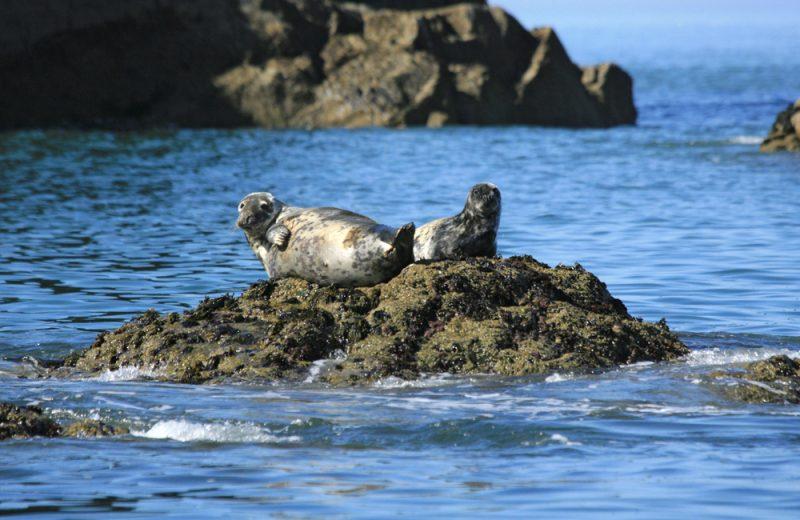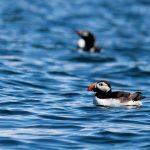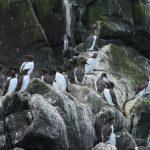Summer is a particularly rewarding time to get out on the water. Equipped with a sea-worthy kayak and good seamanship we can reach some truly wild and special areas that are havens for wildlife. Witnessing the buzz and clamour of a seabird colony, being escorted by seals or startled by a porpoise as it bursts through the water for breath are memorable experiences to have from a kayak. Here are a few simple guidelines that can help avoid any unintended consequences from our visit. The last thing we want to do is disturb the wildlife we have set out to see.
What impact do sea kayakers have?
Unlike a boat with an engine, sea kayaks tend not to announce their presence with noise. We creep along and turn a corner silently, innocently startling wildlife and causing a commotion or a defensive response. In some places seals and seabirds have become accustomed to the regular traffic of wildlife watching tour boats and these boats can approach colonies with little effect on the animal’s behaviour. Visit the very same colonies in a sea kayak and the members get fidgety before you get even half as close.
What is ‘disturbance’?
Being alert for changes in behaviour. A group of guillemots lined up on a nesting ledge bobbing and craning their heads whilst flapping their wings then taking to the air for example, are signs that you have drifted too close and need to back off. Seals previously asleep and relaxed on a beach that begin looking your way and moving towards the water as you drift past, are being disturbed by your presence and need to be given a wider berth.

Why does it matter?
Substantial evidence shows that disturbance can have serious long-term impact on populations of marine animals. During the breeding season, it may mean a missed feed vital for a seal pup’s survival, whilst disturbing nesting seabirds may send eggs or chicks tumbling over the cliff edge as the adults take to the air in fright. Guillemots are particularly vulnerable as they lay a single egg directly on to the rock ledge and won’t lay again if the egg is lost. At other times of the year, disturbance may simply create more stress for animals already facing increasing pressures on their environment.
Code of conduct
There are several pretty comprehensive published guidelines for specific areas or animals, outlining seasonal access restrictions.
- British Canoeing and the RSPB teamed up to produce ‘You, Your Canoe and the Marine Environment’; environmental good practice guidelines for sea kayakers
- The Pembrokeshire Marine Code is a useful code of conduct, which includes seasonal agreed access restrictions for wildlife sensitive areas in Pembrokeshire. The Pembrokeshire Marine Code App is free to download, which includes maps of the sensitive area, fact sheets and invasive species information
- The Scottish Marine Wildlife Watching Code: a guide to best practice for watching wildlife is particularly relevant to Scottish waters
The general message is the same, to minimise disturbance to wildlife. Below are some top tips that will help you create a harmonious kayaking experience, for you and the wildlife.
Top tips for paddling lightly
- Do your research. Are there areas on your route that are sensitive for wildlife, have marine codes of conduct or seasonal access restrictions?
- Keep your distance and keep noise to a minimum especially during the breeding season; seabirds – March to July inclusive; grey seals – August to November inclusive
- Learn to recognise signs of disturbance for animals you are likely to encounter
- Watch from a distance at first and approach slowly and quietly from an oblique angle rather than head on or from behind. Look out for changes in behaviour as your approach
Each of us can be an ambassador for the marine environment by learning more about the wildlife we encounter. Be mindful of those we share the oceans with and paddle lightly on our adventures.
Spotlight on the Pembrokeshire Marine Code
The Pembrokeshire Marine Code was developed as a voluntary guide by local tourism operators, the Pembrokeshire Coast National Park Authority, the RSPB and other organisations. It aims to help protect marine wildlife from disturbance by people. In association with Canoe Wales and the Pembrokeshire Outdoor Charter Group it has also been adapted with kayakers in particular in mind:
The guidelines include maps that detail seasonal access restrictions to particularly sensitive areas of the coast for seabirds and Atlantic grey seals. The restrictions apply from 1st March to 31st July for sea birds nesting on sea cliffs and from 1st August to 30th November for Atlantic grey seal pupping beaches and bays to correspond with their breeding seasons. The maps can be downloaded directly from the Pembrokeshire Marine Code website and are also available in a waterproof version that fits neatly in your buoyancy aid (contact the Marine Code Officer for your copy). Their app for mobile devices is also excellent. It’s an essential resource for planning sea kayak trips in Pembrokeshire, empowering you to be considerate to the wildlife that makes this area so special. Learning about the local animals and the places they inhabit will certainly get you inspired for a trip to Wales.

